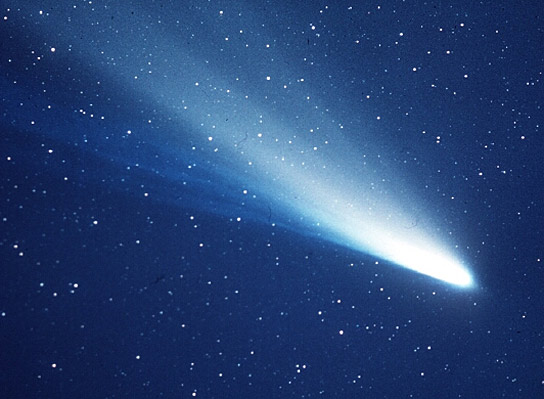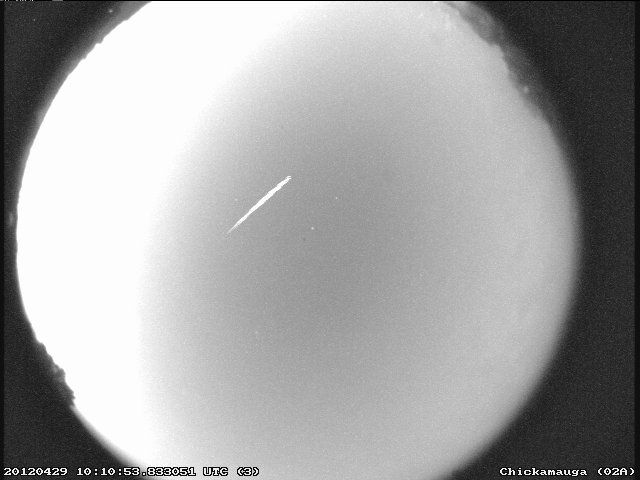
Early Sunday (May 5), just before dawn, we'll have an opportunity to see some of the remnants of the most famous of comets briefly light up the early morning sky.
The famed Halley's Comet made its last pass through the inner solar system in 1986 and is not due back until the summer of 2061. But each time Halley sweeps around the sun, it leaves behind a dusty trail — call it "cosmic litter" — that is responsible for two meteor showers on Earth each year. The first of those "shooting stars" displays, the Eta Aquarid meteor shower, will peak on Sunday.
The Eta Aquarid meteor shower occurs each year in early May because the orbit of Halley's Comet closely approaches the orbit of Earth in two places. The first is the May timeframe, which leads to the Eta Aquarids. The other point occurs in mid-October, producing the Orionid meteor shower. [Meteor Shower Quiz: Do You Wish on Shooting Stars?]
When and Where to Watch
The Eta Aquarid meteor shower is predicted to peak early on Sunday morning, but dark skies and clear weather are vital to observe them. Under ideal conditions (a dark, moonless sky) about 55 to 60 of these very swift meteors might be seen per hour.
The meteor shower appears at about one-quarter of its peak strength for several days before and after May 5. This is a very good year to look out for the Eta Aquarid meteors from Halley's Comet because the moon will be at a thin, waning crescent phase, and just 20-percent illuminated and providing little interference for viewing these swift streaks of light.
From places south of the equator, the Eta Aquarids typically put on very good show. Australian stargazers consider them to be the best meteor display of the year.
Get the Space.com Newsletter
Breaking space news, the latest updates on rocket launches, skywatching events and more!
But for those watching from north of the equator, it's a much different story.

Where to look
The apparent origin point of a meteor shower in the night sky is known as its radiant. For the Eta Aquarids, the radiant is found within the "Water Jar" of the constellation Aquarius, which begins to rise above the eastern horizon around 3 a.m. your local time. Unfortunately, this constellation never really gets very high as seen from north temperate latitudes. And soon after 4 a.m. local time, the morning twilight will begin to brighten the sky.
So if you are hoping to see up to 60 meteors per hour, forget it. With the radiant so low above the horizon, the majority of those meteors will be streaking below the horizon and out of sight.
In fact, from North America, typical Aquarid rates are only 10 meteors per hour at 26 degrees north latitude (Miami, Fla., or Brownsville, Texas), 5 per hour at around 35 degrees latitude (Los Angeles, Calif., or Cape Hatteras, N.C.) and practically zero to the north of 40 degrees (New York, Chicago, and Philadelphia).
"So," you may be thinking, "What's the point of getting up before dawn to watch?"
The answer: Despite the long odds, you still just might see something spectacular.
Catch an Earthgrazer, or comet crumb
For most, perhaps the best hope is perhaps catching a glimpse of a meteor emerging from the radiant that will skim the atmosphere horizontally — much like a bug skimming the side window of an automobile.
Meteor watchers call such shooting stars "earthgrazers" and they are known for spectacularly long, colorful, long-lasting trails.
"These meteors are extremely long," Robert Lunsford of the International Meteor Organization explained. "They tend to hug the horizon rather than shooting overhead where most cameras are aimed."
"Earthgrazers are rarely numerous," NASA meteor expert Bill Cooke, a member of the Space Environments team at the Marshall Space Flight Center has said. "But even if you only see a few, you're likely to remember them."
If you do catch sight of one early these next few mornings, remember that you are likely seeing the incandescent streak produced by material which originated from the core of Halley's Comet.
So it is that the shooting stars that we have come to call the Eta Aquarids are really an encounter with the traces of a famous visitor from the depths of space and from the dawn of creation.
Editor's note: If you have an amazing picture of any night sky view that you'd like to share for a possible story or image gallery, send photos, comments and your name and location to managing editor Tariq Malik at spacephotos@space.com.
Joe Rao serves as an instructor and guest lecturer at New York's Hayden Planetarium. He writes about astronomy for Natural History magazine, the Farmer's Almanac and other publications, and he is also an on-camera meteorologist for News 12 Westchester, New York. Follow us on Twitter, Facebook and Google+. Original article on SPACE.com.
Join our Space Forums to keep talking space on the latest missions, night sky and more! And if you have a news tip, correction or comment, let us know at: community@space.com.

Joe Rao is Space.com's skywatching columnist, as well as a veteran meteorologist and eclipse chaser who also serves as an instructor and guest lecturer at New York's Hayden Planetarium. He writes about astronomy for Natural History magazine, Sky & Telescope and other publications. Joe is an 8-time Emmy-nominated meteorologist who served the Putnam Valley region of New York for over 21 years. You can find him on Twitter and YouTube tracking lunar and solar eclipses, meteor showers and more. To find out Joe's latest project, visit him on Twitter.









